Geelvink Pygmy Parrot |
|
|
Also known as: Biak Pygmy Parrot
Photos
View in GalleryDid You Know?
The Pygmy parrots have extra-long toes to help them climb easily in the trees. They also have very strong, stiffened tailfeathers to help them brace against tree trunks.Academic Research
Related publications: Micropsitta geelvinkianaSpecies Profile
Genus: Micropsitta | Species: geelvinkiana
Size:
9cm (3.5 in)
Weight:
13-17g (0.45-0.6 oz)
Subspecies including nominate:
two: M.g. geelvinkiana, M.g. misoriensis
Colour Adult:
M.g. geelvinkiana: Male-green underwing coverts; deep grey/brown forehead, lores to cheeks and ear coverts, the cheek feathers margined with dark blue; deep purple/blue crown to eyes, bordered on occiput by varying yellow patch; blue throat to sides of foreneck; orange/yellow centre of breast and abdomen; blue central tail feathers, with green/black lateral feathers. Bill grey. Eye brown/red. Female-paler grey/brown face and forecheeks, with green hindcheeks and ear coverts; yellow patch on occiput absent; green/yellow underparts.
M.g. misoriensis: Male-dark grey/brown head, with blue line bordering on hindneck; yellow mark on nape. Female-as in male, but yellow on nape absent; crown feathers faintly margined with blue.
Colour Juvenile:
M.g. geelvinkiana: As in adult female but with pale yellow bill tipped with grey/brown.
Call:
Calls are high-pitched short "tsee tsee”. Also short high-pitched warbled notes.
Listen NowVideo Links:
Video 1More Information:
Content Sources:
CITES
Birding Indonesia
BirdLife International
Cornell Lab of Ornithology/Birds of the World
Parrots: A Guide to Parrots of the World, Juniper and Parr, 1998.
xeno-canto Geelvink Pygmy Parrot, Aberg, Patrik XC40325
Parrots of the World, Forshaw, 2006. 2010 edition
Lexicon of Parrots, Thomas Arndt.
Photos
View in GalleryDid You Know?
The Pygmy parrots have extra-long toes to help them climb easily in the trees. They also have very strong, stiffened tailfeathers to help them brace against tree trunks.Academic Research
Related publications: Micropsitta geelvinkianaSpecies Care
Captive Status:
Not found in aviculture.
Longevity:
Not recorded.
Housing:
Not recorded.
Diet:
Not recorded.
Enrichment:
Not recorded.
Nest Box Size:
Not recorded.
Clutch Size:
Possibly 2.
Incubation Time:
Not recorded.
Fledging Age:
Not recorded.
Hatch Weight:
Not recorded.
Peak Weight:
Not available
Weaning Weight:
Not recorded.
Photos
View in GalleryDid You Know?
The Pygmy parrots have extra-long toes to help them climb easily in the trees. They also have very strong, stiffened tailfeathers to help them brace against tree trunks.Academic Research
Related publications: Micropsitta geelvinkianaSpecies Wild Status
World Population:
Unknown, thought to be stable.
IUCN Red List Status:
Least Concern
CITES Listing:
Appendix II
Threat Summary:
Not globally threatened. A BirdLife “restricted-range” species. There has been no noticeable population decline in the past twenty years.
Range:
M.g. geelvinkiana Numfor Island in Geelvink Bay.
M.g. misoriensis: Biak Island in Geelvink Bay.
Habitat:
Found up to 300m (9840 ft) in lowland forest, secondary growth forest, open cultivated areas with isolated trees and gardens.
Wild Diet:
Probably lichen, fungi, seeds, flowers, fruits and insects and their larvae.
Ecology and Behaviour:
Usually seen in groups of 4-5 birds. Very shy. Will associate with other birds in low lying shrubbery.
Clutch and Egg Size:
Possibly 2.
Breeding Season:
Probably June-August. Nest is in arboreal termitarium.
Photos
View in GalleryDid You Know?
The Pygmy parrots have extra-long toes to help them climb easily in the trees. They also have very strong, stiffened tailfeathers to help them brace against tree trunks.Academic Research
Related publications: Micropsitta geelvinkianaMembers Only Resources
Please log-in now to find more research, resources and tools.
Not a Member?
Find more great information:
Gain exclusive access to 600+ pages of additional research, seminars and podcasts, specialists to ask your toughest questions, and dozens of other fun resources - when you become a WPT member.
Join Today >>

































